
About this breed
Information on this page courtesy of the Royal Kennel Club
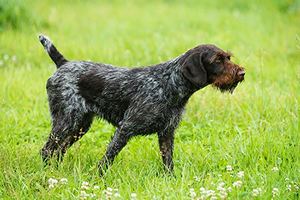 A larger, more rugged version of his smooth haired cousin, the German Wirehaired Pointer has a harsh bristly coat to give him protection in rough cover and rough weather.
A larger, more rugged version of his smooth haired cousin, the German Wirehaired Pointer has a harsh bristly coat to give him protection in rough cover and rough weather.
The German Wire Haired Pointer was developed from several wire-coated pointing breeds popular in Germany in the 19th century. It has been suggested that French Griffon blood was also used.
The German Wire Haired Pointer is a rugged and indefatigable worker.
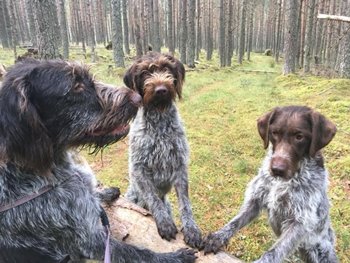
Breed standard colours
Breed standard colours in the GWP include:
Size
Ideal height at shoulder:
Weight
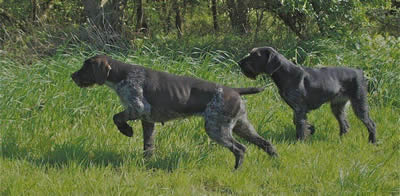
The breed standard
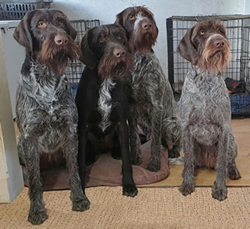
General appearance: Medium-sized hunting dog, with wire hair completely covering skin. Overall should be slightly longer in body, compared to shoulder height.
Characteristics: Powerful, strong, versatile hunting dog, excels in both field and water. Loyal, intelligent, sound temperament and alert.
Temperament: Gentle, affectionate and even tempered. Alert, biddable and very loyal.
Head and skull: Balanced in proportion to body. Skull sufficiently broad and slightly rounded. Moderate stop, skull and muzzle of equal length with no overhanging lips. Nose liver or black.
Eyes: Medium-sized oval, hazel or darker, with eyelids closing properly, not protruding nor too deep set.
Ears: Medium sized in relation to head, set high, when brought forward should reach corner of lips.
Mouth: Teeth and jaws strong, with perfect regular and complete scissor bite, i.e. upper teeth closely overlapping lower teeth and set square to the jaws, with full dentition.
Neck: Strong and of adequate length, skin tightly fitting.
Forequarters: Shoulders sloping and very muscular with top of shoulder blades not too close; upper arm bones between shoulder and elbow long. Elbows close to body, neither pointing outwards nor inwards. Forelegs straight and lean, sufficiently muscular and strong but not coarse-boned. Pasterns slightly sloping, almost straight but not quite.
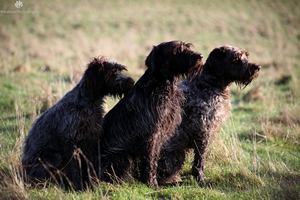 Body: Chest must appear deep rather than wide but not out of proportion to the rest of the body; ribs deep and well sprung, never barrel shaped nor flat, back rib reaching well down to tucked-up loins. Chest measurement immediately behind elbows smaller than that of about a hand's breadth behind elbows so that upper arm has freedom of movement. Firm back, not arched, with slightly falling back line.
Body: Chest must appear deep rather than wide but not out of proportion to the rest of the body; ribs deep and well sprung, never barrel shaped nor flat, back rib reaching well down to tucked-up loins. Chest measurement immediately behind elbows smaller than that of about a hand's breadth behind elbows so that upper arm has freedom of movement. Firm back, not arched, with slightly falling back line.
Hindquarters: Hips broad and wide, croup falling slightly towards tail. Thighs strong and well muscled. Stifles well bent. Hocks square with body, turning neither in nor out. Pasterns nearly upright. Bone strong but not coarse.
Feet: Compact, close knit, round to oval shaped, well padded, should turn neither in nor out. Toes well arched, heavily nailed.
Tail: Previously customarily docked.
Docked: Approximately two fifths of original length docked. Continuing the line of back, carried horizontally or slightly upward. Neither too thick nor too thin.
Undocked: Continuing the line of back, carried horizontally or slightly upward. Neither too thick nor too thin. Reaching to the hocks and carried straight or slightly sabre fashion.
Gait/movement: Smooth, covering plenty of ground with each stride, driving hind action, elbows turning neither in nor out. Definitely not a hackney action.
Coat: Outer coat thicker and harsh, no longer than 4 cms (11/2 ins) long with a dense undercoat, (undercoat more prevalent in winter than summer). It should not hide body shape but it should be long enough to give good protection. Coat should lie close to the body. Hair on head and ears thick and short, but not too soft. Bushy eyebrows, full but not overlong beard.